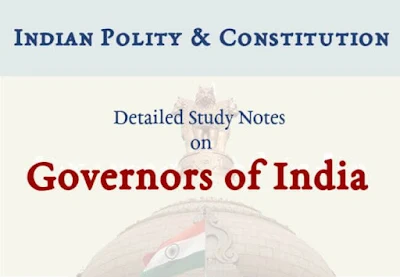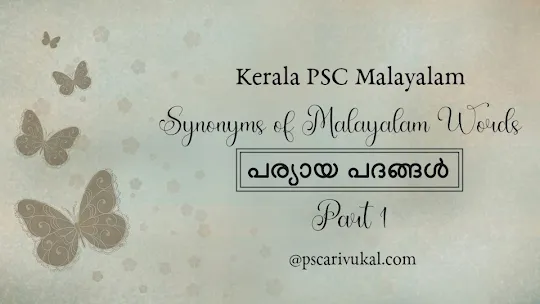Term – 5 years
Appointed by – President of India
Qualification – Indian Citizen, 35 Years Old
The Indian Constitution of 1949 states that there should be a Governor for every State and Union territories in India. Governors of India are appointed by the President of India. They are the titular executive head of all the 28
states and 8 union territories.
Governors of the union territories are known as the
'Lieutenant Governor / Chief Commissioner / Administrator' because UTs
are directly under the President of India who in turn appoints an
administrator to govern them under his aegis.
In Andaman and Nicobar Islands, Delhi, Jammu & Kashmir, and
Puducherry, this official is called 'Lieutenant Governor',
while in Chandigarh, Dadra-Nagar Haveli, Daman-Diu and Lakshadweep, they are
called 'Administrator.'
Articles Pertaining to the Governor in the Indian Constitution
Part VI of the Indian Constitution deals with the States.
Under Part VI, Chapter I & II Articles 153-162 of the Indian
Constitution provides for the Governor of the States. (Chapter I is for State definition and Chapter II deals with the Governors)
- Article 153 –
- There shall be a Governor for each State.
- The same person cannot be appointed as the Governor for two or more States.
- Article 154 – Executive Powers
- Article 155 – Appointment
- Article 156 – Term of Office
- Article 157 – Qualifications
- Article 158 – Conditions
- He/She shall not be a member of either House of Parliament or of a House of the Legislature of any State.
- He/She shall not hold any other office of profit.
- Article 159 – Oath By the Governor
- Article 160 – Discharge of the functions of the Governor in certain contingencies.
- Article 161 – Power of Governor to grant pardons, etc, and to suspend, remit or commute sentences in certain cases.
- Cannot pardon a death sentence.
- Article 162 – Extent of Executive Powers of States.
- Article 164 – Power to appoint Chief Minister and council of Ministers for the State.
- Article 165 – Power to appoint the Advocate General for the State.
- Article 166 – States all executive action of the Government of a State shall be expressed to be taken in the name of the Governor.
- Article 174 – Allows Governor to dissolve the Legislative Assembly.
- Article 175 – Right to address and send messages to the House.
- Article 176 – Special address to the House by the Governor.
- Article 192 – Allows the Governor to disqualify a member of the legislative assembly under the recommendation of the state election commission.
- Article 193 – deals with the discretionary power of the Governor. Unlike the President, the Governor has absolute power and his decision is final.
- Article 200 – Assent to Bills: withholds assent, or reserves bills presented by the House.
- Article 202 – Annual financial statements relating to estimates and expenditures.
- Article 213 – Power of Governor to promulgate Ordinances during recess of Legislature.
- Article 217 – Power to appoint High Court Judge for the State.
- Article 353 – During an emergency, the governor can assert his power through Article 193 overriding the state legislative assembly.
- Article 361 – deals with the protection of President and Governors and Rajpramukhs.
Appointments made By the Governor
- Advocate General of the State
- Chief Minister & Council of Ministers of the State
- Judges of High Court & District Courts
- Chairman and Members of the State Public Service Commission
- State Election Commissioner
- Advocate General of the State
- Chief Minister & Council of Ministers of the State
- Judges of High Court & District Courts
- Chairman and Members of the State Public Service Commission
- State Election Commissioner
Powers of The Governor
The power of the Governor can be broadly classified into
-
Executive Powers:
The Chief Minister of the state keeps the Governor informed on all
matters pertaining to the state and about the council of ministers. He
and his ministers can advise the Governor on important matters
according to Article 163(3) of the Constitution
but Article 193 clearly states that even though he
can take the advice into consideration, the power of decision making
vested in him is absolute.
-
Financial Powers:
No money bill or other financial aids can be presented in the
legislative assemblies without the advice/recommendation by the
Governor. It is quite similar to the power of the President. The
report from the Auditor General containing the income and expenditure
of the state is presented to the Governor annually.
-
Legislative Powers:
The Governor can summon and dissolve the state legislative assemblies.
Another power the Governor exercises is that if a bill is passed by
the state legislative assembly, it can't become an Act until he/she
gives his/her consent.
-
Judicial Powers:
The Governor can exercise this power through Article 161 & 192.
Appointment on High Court Chief Justice and other judges of the state on the advice of
the President is done by the Governor.
- Discretionary Powers:
- Can impose President's Rule.
- Can present his own report to the President of India directly on the internal affairs of the state.
- Can withhold his consent to a bill and send it directly to the President for approval/dismissal.
- When a Hung Parliament occurs, the governor can choose a suitable candidate who can form a majority coalition as Chief Minister.
During his term of office, he/she is entitled to the various allowances,
emoluments, and privileges which are determined by Parliament by law (as mentioned under the II schedule) and it can't be revoked.
Termination
Usually, Governors can serve until the expiration of his term, but under
Article 160, they can be terminated earlier if:
- The term of Governor can be dismissed by the President, at whose pleasure he/shes holds the office. It means President on the advice Prime Minister can dismiss the Governor.
- The Governor may himself apply for resignation, by writing directly to the President.
Dismissal of Governors so far
The first such incident happened in 1977, for the first time when a
non-congress government, Janata Govt. came into power. Many such dismissals happened in the Indian history and most of times, it was due to political rivalries. The timeline of such
incidents so far is as following:
- 1977 – Janata Govt dismissed 15 governors.
- 1980 – Tamil Nadu Governor Prabhudas Patwari was dismissed
- 1981 – Dismissal of Rajasthan Governor Raghukul Tilak
- 1998 – Dismissal of Gujarat Governor Krishna Pal Singh by the BJP Govt.
- 2001 – Tamil Nadu Governor M. Fathima Beevi was dismissed by NDA Govt.
- 2004 – UPA Govt dismissed 4 Governors from the states Goa (Kidar Nath Sahni), Gujarat (Kailashpati Mishra), Haryana (Babu Parmanand) & UP (Vishnu Kant Shastri)
- 2014 – Under the Modi Govt, Puducherry Governor Virendra Kataria & Gujarat Governor Kamla Beniwal was sacked.
The dismissal of Governor became regular happening every time when a new the government came into power. It was then the famous "B.P. Singhal VS Union of India (2010) case" (cause: the dismissal of 4 Governors in 2004) was filed in Supreme
Court.
A constitutional bench of the Supreme Court under the recommendation of
following commissions,
- Sarkaria Commission (1988)
- Venkatachaliah Commission (2002)
- Punchhi Commission (2010)
The second clarification is that even if the ideology and political the stance of the Governor differs from the newly elected Govt. that is not
sufficient reason for dismissal and if such dismissal happens, it can be challenged in
the court of law.







Post a Comment
Post a Comment